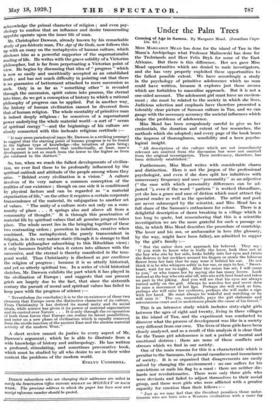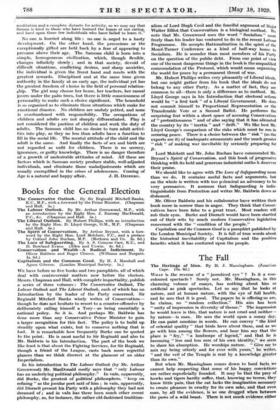Under the Palm Trees
MISS MARGARET MEAD has done for the island of Tau in the Manu'a Archipelago what Professor Malinowski has done for the Trobriands and Herr Felix Bryk for some of the East Africans. But there is this difference. Her sex gave Miss
• Mead opportunities which are denied to male investigators, and she has very properly exploited these opportunities to the fullest possible extent. We have accordingly a study in the psychology of primitive adolescence which no man could have written, because it explores just those arcane which are forbidden to masculine approach. But it is not a one-sided account. The adolescent girl must hnve an environ- ment; she must be related to the society in which she lives. Judicious selection and emphasis have therefore presented a tolerably clear picture of Samoan culture in Tau, and we can gauge with the necessary accuracy the societal influences which shape the problems of adolescence.
Miss Mead has been scrupulously careful to give us her credentials, the duration and extent of her researches, the methods which she adopted ; and every page of the book bears the impress of thoroughness, sensibility and a keen psycho- logical insight.
"AU descriptions of the culture which are not immediately relevant are omitted from the discussion but were -not omitted from the original investigation. Their irrelevancy, therefore, has been definitely established."
Furthermore, Miss Mead writes with considerable charm and distinction. Hers is not the jargon of the professional psychologist, and even if she does split her infinitives with unnecessary frequency and uses " personality " as an adjective (" the ease with which personality differences can be ad- justed "), even if the word " pattern " is worked threadbare, yet she has a grace and ease of diction which mist attract the general reader as well as the specialist. The artist and poet are never submerged by the scientist, and Miss Mead has a full share of the Samoan's enthusiasm for colour. There is it delightful description of dawn breaking in a village which is too long to quote, but remembering that this is a scientific investigation we are the more grateful for such a passage as this, in which Miss Mead describes the procedure of courtship. The lover and his sea, or ambassador in love (the glossary, by the way, might have been fuller), are admitted to supper by the girl's family :— "But the suitor does not approach his beloved. They say : If you wish to know who is really the lover, look then not at the boy who sits by her side, looks boldly into her eyes and twists the flowers in her necklace around his fingers or steals the hibiscus flower from her hair that he may wear it behind his ear. Do not think it is he who whispers softly in her ear, or says to her, " Sweet- heart, wait for me to-night. After the moon has set, I will come to you," or who teases her by saying she has many lovers. Look instead at the boy who sits afar off, who sits with bent head and takes no part in the joking. And you will see that his eyes are always turned softly on the girl. Always he watches her and never does he miss a movement of her lips. Perhaps she will wink at him, perhaps she will raise her eyebrows, perhaps she will make a sign with her hand. He must always be wakeful and watching or he will miss it.' The Boa, meanwhile, pays the girl elaborate and ostentatious court and in undertones pleads the cause of his friend."
This is an intensive study which includes sixty-eight girls between the ages of eight and twenty, living in three villages in the island of Tau, and the experiment was conducted to discover what the process of development was like in a society very different from our own. The lives of these girls have been closely analysed, and as a result of this analysis it is clear that for the Tauan girl adolescence is not a period of mental and emotional distress : there are none of those conflicts and stresses which we find in our society.
One of the main reasons for this is a characteristic which is peculiar to the Samoans, the general casualness and insouciance of society. It is so organized that disagreements are easily solved by changing the environment: no one suffers for his convictions or nails his flag to a mast: there are neither die- hards nor revolutionaries. There were only three girls who were deviants and faired to adjust themselves to their social group, and these were girls who were afflicted with a greater capacity for emotion than their fellows :—
"Just as we may feel that the Occident penalizes those unfor- tunates who are born into a Western civilization with a taste for
meditation and a complete distaste for activity, so we may say that Samoa is kind to those who have learned the lesson of not caring, and hard upon those few individuals who have failed to learn it."
. No one is hurried along life : no one is urged to a hasty development. On the other hand, the precocious or the exceptionally gifted are held back by a fear of appearing to presume above their age. The Samoan child is born into a simple, homogeneous civilization, which, though flexible, changes infinitely slowly ; and hi that society, devoid of difficult situations, conflicting desires, and sharp anxieties, the individual is given the freest hand and meets with the greatest rewards. Disciplined and at the same time given authority in the family at an early age, the individual yet has the greatest freedom of choice in the field of personal relation- ship. The girl may choose her home, her teachers, her casual „lovers under the palm trees, but there is little consciousness of personality to make such a choice significant. The household is so organized as to eliminate those situations which make for emotional disaster. No children are unduly petted, and none is overburdened with responsibility. The occupations of children and adults are not sharply differentiated. Play is not considered the pastime of children and work the duty of adults. The Samoan child has no desire to turn adult activi- ties into play, as they no less than adults have a function to fill in the social life. The mental attitude of the child and the adult is the same. And finally the facts of sex and birth are not regarded as unfit for children. There is no secrecy, ignorance, or guilty knowledge. There is no danger therefore of a growth of undesirable attitudes of mind. All these are factors which in Samoan society produce stable, well-adjusted individuals, and eliminate those maladjustments which are usually exemplified in the crises of adolescence. Coming of Age is a natural and happy affair. J. H. DRIBERG.













































 Previous page
Previous page